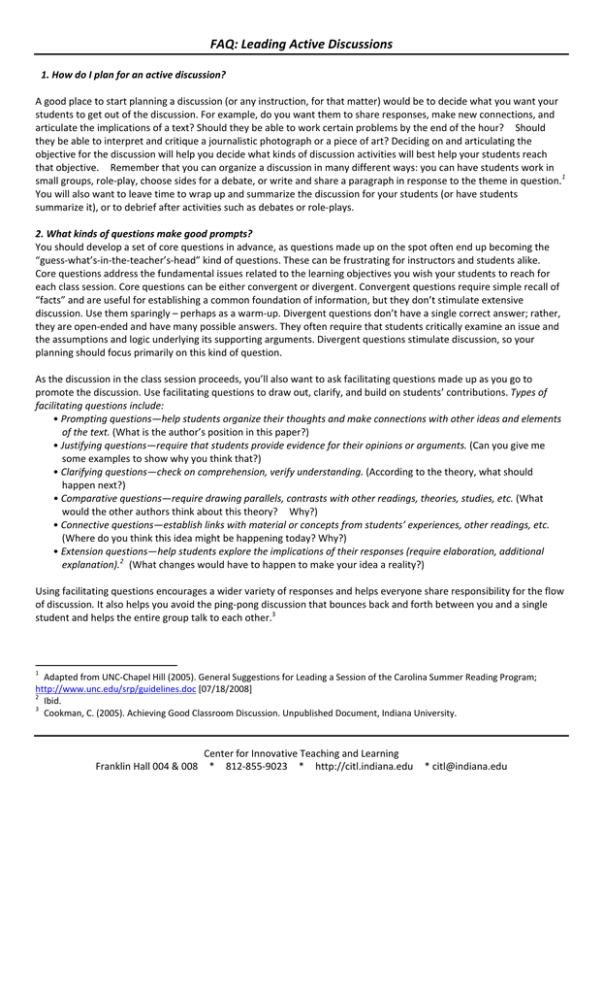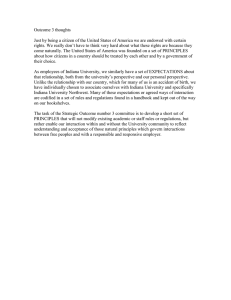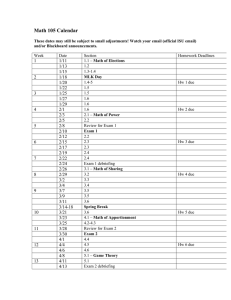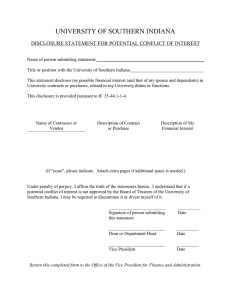FAQ: Leading Active Discussions - Center for Innovative Teaching
advertisement

FAQ: Leading Active Discussions 1. How do I plan for an active discussion? A good place to start planning a discussion (or any instruction, for that matter) would be to decide what you want your students to get out of the discussion. For example, do you want them to share responses, make new connections, and articulate the implications of a text? Should they be able to work certain problems by the end of the hour? Should they be able to interpret and critique a journalistic photograph or a piece of art? Deciding on and articulating the objective for the discussion will help you decide what kinds of discussion activities will best help your students reach that objective. Remember that you can organize a discussion in many different ways: you can have students work in small groups, role‐play, choose sides for a debate, or write and share a paragraph in response to the theme in question.1 You will also want to leave time to wrap up and summarize the discussion for your students (or have students summarize it), or to debrief after activities such as debates or role‐plays. 2. What kinds of questions make good prompts? You should develop a set of core questions in advance, as questions made up on the spot often end up becoming the “guess‐what’s‐in‐the‐teacher’s‐head” kind of questions. These can be frustrating for instructors and students alike. Core questions address the fundamental issues related to the learning objectives you wish your students to reach for each class session. Core questions can be either convergent or divergent. Convergent questions require simple recall of “facts” and are useful for establishing a common foundation of information, but they don’t stimulate extensive discussion. Use them sparingly – perhaps as a warm‐up. Divergent questions don’t have a single correct answer; rather, they are open‐ended and have many possible answers. They often require that students critically examine an issue and the assumptions and logic underlying its supporting arguments. Divergent questions stimulate discussion, so your planning should focus primarily on this kind of question. As the discussion in the class session proceeds, you’ll also want to ask facilitating questions made up as you go to promote the discussion. Use facilitating questions to draw out, clarify, and build on students’ contributions. Types of facilitating questions include: • Prompting questions—help students organize their thoughts and make connections with other ideas and elements of the text. (What is the author’s position in this paper?) • Justifying questions—require that students provide evidence for their opinions or arguments. (Can you give me some examples to show why you think that?) • Clarifying questions—check on comprehension, verify understanding. (According to the theory, what should happen next?) • Comparative questions—require drawing parallels, contrasts with other readings, theories, studies, etc. (What would the other authors think about this theory? Why?) • Connective questions—establish links with material or concepts from students’ experiences, other readings, etc. (Where do you think this idea might be happening today? Why?) • Extension questions—help students explore the implications of their responses (require elaboration, additional explanation).2 (What changes would have to happen to make your idea a reality?) Using facilitating questions encourages a wider variety of responses and helps everyone share responsibility for the flow of discussion. It also helps you avoid the ping‐pong discussion that bounces back and forth between you and a single student and helps the entire group talk to each other.3 1 Adapted from UNC‐Chapel Hill (2005). General Suggestions for Leading a Session of the Carolina Summer Reading Program; http://www.unc.edu/srp/guidelines.doc [07/18/2008] 2 Ibid. 3 Cookman, C. (2005). Achieving Good Classroom Discussion. Unpublished Document, Indiana University. Center for Innovative Teaching and Learning Franklin Hall 004 & 008 * 812‐855‐9023 * http://citl.indiana.edu * citl@indiana.edu 3. What kinds of interpersonal skills can I use to encourage discussion? You can encourage discussion by using various interpersonal skills to communicate empathy, interest in the students, and engagement in the discussion itself. Try to use positive body language, such as strong eye contact, an open posture, head nods, and appropriate facial expressions. You should also model active listening techniques for your students by making reflection/mirroring statements, giving "I'm listening" cues, summarizing and paraphrasing responses, using silence strategically, and making empathetic statements.4 4. If I want to encourage discussion in my class, is there anything special I should do on the first day of class? If you plan to make discussion part of your teaching repertoire, use it in the very first class of the semester. Early in the semester you might also want to establish ground rules for discussions; in fact, this might be a good discussion topic, since student‐generated rules are more effective than those you suggest yourself. Sample ground rules might include requiring that all contributions be on‐topic, agreeing that it’s more important to find the best answer to a question than to “win” an argument, and so on. 5. Sometimes it’s hard to get students talking. How do I get a discussion started? Try dividing students into pairs or small groups and asking them to discuss a question in their groups. Then after a few minutes of small group discussion, ask several groups to report out their ideas to the entire class. This often helps to get discussion going because students have had a chance to “try out” their ideas on their peers. Alternatively, give students time to write individually before opening up a discussion; they are much more likely to speak up if they have some notes to speak from. Further, by allowing for these kinds of pre‐discussion activities, you will be able to ask more complex and interesting questions. At the same time you will be promoting equity in the conversation, allowing everyone in the class to gather his or her thoughts before speaking rather than privileging the bold or the entitled, who can otherwise dominate the discussion. 6. How can I resist the urge to lecture? Do not revert to lecture if discussion does not take off. If a question misfires, ask it again in a different way. Remember to WAIT for a response, even if the wait becomes slightly uncomfortable – silence can simply mean that students are thinking. Though it may feel to you like a long wait, students will often give thoughtful responses if they have enough time to gather those thoughts. Think in terms of asking questions rather than making declarative statements. You might respond to a student question with another question, using it as a building block in the architecture of the discussion. You might also use redirection, by (for example) asking students to evaluate and respond to each other’s answers. 7. How can I keep the discussion moving along briskly? To help students use discussion time most productively, allow students only a few moments to speak or discuss at a time—perhaps three to five minutes. Prof. Peter Saunders of Oregon State University’s Center for Teaching and Learning suggests using electronic timers to encourage students to begin to internalize a sense of time and learn when they need to focus quickly.5 Plan ahead using these short increments as building blocks so that you have an idea of how long each section of the discussion should last, and make sure to allow time at the end to wrap up, summarize, or debrief. 8. How can I handle students who monopolize discussion? If the same students answer all the time, you might say, “Let’s hear from someone else.” Then don’t call on students who have already spoken. Do not allow one student to speak for an inordinate amount of class time. Take that person aside and ask him or her to limit comments in class. If the student does not respond to this hint, tell him or her an exact number of times he or she will be allowed to respond in class, and do not call on him or her after that number has been reached in any class period. 9. How can I maintain control of a discussion? This is where a set of discussion ground rules agreed upon by the whole class can really come in handy (see question 4). Gently, students can be reminded that behavior X (e.g. interrupting, solving the crossword, showing disrespect) is not appropriate in the context of the rules the class agreed on. If no rules have been established, or if the inappropriate 4 Adapted from UNC‐Chapel Hill (2005). General Suggestions for Leading a Session of the Carolina Summer Reading Program; http://www.unc.edu/srp/guidelines.doc [07/18/2008] 5 Academic Leader [magnapubs@e.mailzeen.com] “Try Timers to Keep Students on Task and on Track.” Fifteen survival strategies for new college instructors. Saunders, P. (2007). Online Seminars. Email to the author. 25 Jul 2008. FAQ: Leading Active Discussions behavior doesn’t seem to fit under the rules, you should address it immediately. Otherwise, you send a clear message to the students that such behavior is acceptable. Often, simply walking toward the student(s) will resolve the problem, as they will see that you are paying attention. Sometimes, however, you will need to address the problem directly. Try not to get rattled—take a deep breath, allow some silence, and then respond. This gives you some time to plan a response that models for the students how to handle a difficult situation. Remember: never shame or humiliate a student, and don’t take student remarks personally—although an attack may seem personal, it may be directed at authority figures in general rather than at you in particular. 10. How can I diplomatically tell a student their response is not right? First of all, don’t ignore wrong answers; you don’t want your students to leave class thinking that a wrong answer is correct. Without saying the answer is correct, point out where the student raised interesting points or was approaching the correct answer. Then go on to point out where and why his or her response was incorrect. You can even use this process to prompt further discussion from the class, maybe asking for other perspectives or whether someone in the class would like to comment on the response. Although sometimes you will simply have to tell the student that he or she is wrong6, oftentimes, other students will comment on the mistake and set things right for the class. 11. How should I wrap‐up the discussion? It is important to wrap‐up the discussion so that students will have a sense of closure and depart with a common understanding of the intellectual work that was done during that session. You can summarize—or ask the students to summarize—the discussion from time to time during the session, and especially at the end. To gain maximum effectiveness after a simulation, game, role‐play, etc., you must debrief the students afterward. The more abstract, complex, and emotionally intense the simulation is, the more participants will gain from debriefing. Debriefing helps your participants reflect on their experiences, relate them to the real world, discover useful insights, and share them with each other. Debriefing also helps you to wind down the learning activity, reduce negative reactions among the participants, and increase insights. Questions may include, “How do you feel? What happened? What did you learn?” etc. For a description of a six‐phase model for debriefing, see footnote.7 12. How should I grade a discussion? There are several different ways of handling the grading issue. One is to give an explicit grade: Place students in heterogeneous, permanent teams of 5 (create teams based on scores on first assignment, majors, etc.). After each in‐class discussion, each group has to turn in a page from the group, signed by all team members who contributed to it, that summarizes their ideas and contributions. These papers can then be scored with a rubric just as other student work is, and each student receives the grade given to the group’s paper. One advantage of this approach is that although there is some grading involved, it is considerably less than grading each student individually. You could also take a more indirect approach to grading discussions. For example, you could create exam questions or course writing assignments that reflect class discussion activities. Or you could ask students to evaluate a class discussion in writing or tell where they stand on an issue, being sure to apply criteria or models used during the in‐class discussion. 13. How can I find out more about leading discussion? If you have more questions or would like to make an appointment to discuss leading discussions in your class, contact us at citl@indiana.edu or by phone (812‐855‐9023), or visit our website at http://citl.indiana.edu.8 6 Sheffield, S. (2002). “Asking questions.” Retrieved from http://learningandteaching.dal.ca/aqh.html 5 Aug 2008. Thiagaragan, S. (2004). Six phases of debriefing. http://www.thiagi.com/pfp/IE4H/february2004.html#Debriefing [7/18/2008] 8 This FAQ was written by Joan Middendorf, with Katie Kearns, Lisa Kurz, Sarah Marion, and Eric Metzler of Indiana University. 7 Center for Innovative Teaching and Learning Franklin Hall 004 & 008 * 812‐855‐9023 * http://citl.indiana.edu * citl@indiana.edu




